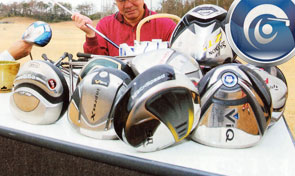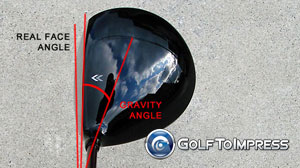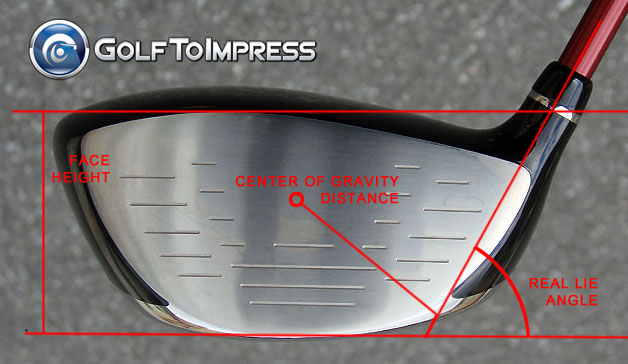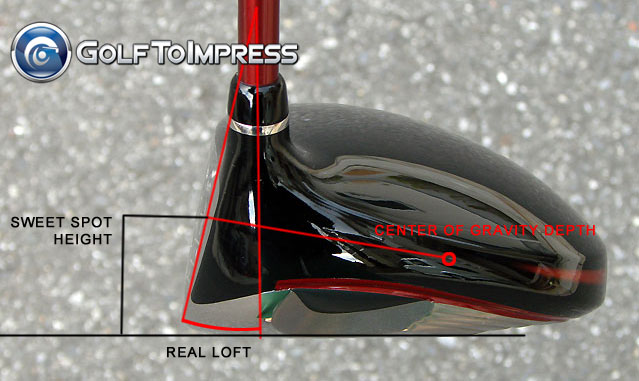So after a week of being away in the very hot tropical island of Palau, I am back in the golfing world here in Japan. The weather was great, the water was crystal clear and diving was fun, but it was hard to believe a place as beautiful as Palau did not have a golf course so I’m glad to be back!
 It’s the time of year here in Japan were many of the top manufacturers are releasing new 2010 models. This is an exciting time for golfers and with so many new drivers to choose from it can sometimes be overwhelming. I’ve talked in the past about driver specs and how different specs can affect a driver’s true performance as well as finding the right shaft.
It’s the time of year here in Japan were many of the top manufacturers are releasing new 2010 models. This is an exciting time for golfers and with so many new drivers to choose from it can sometimes be overwhelming. I’ve talked in the past about driver specs and how different specs can affect a driver’s true performance as well as finding the right shaft.
Today I’m not going to talk about shafts for once but rather look at some interesting numbers provided by Golf Digest Japan on several of the latest and greatest drivers here in Japan. We’re talking about real specs, the loft, the lie, the face angle, the center of gravity, where the sweet spot actually is and more. Many manufacturers state a certain spec on their mass produced drivers but due to manufacturing oddities and quality control, what you see is not what you always get.
 Do real specs make a difference to golfers? For many average and recreational golfers, they probably don’t think twice when buying a driver off the shelf at their local golf shop. However, for the better player, the golf enthusiast, the player struggling with their driver shot, real specs on a driver can make a huge difference.
Do real specs make a difference to golfers? For many average and recreational golfers, they probably don’t think twice when buying a driver off the shelf at their local golf shop. However, for the better player, the golf enthusiast, the player struggling with their driver shot, real specs on a driver can make a huge difference.
Imagine you’re a player who battles a hook and would like to keep the ball from ballooning. You see that new model driver with a 9.5* loft and square face angle and think that is the driver for you to keep the ball straight and get that more penetrating trajectory. What if that driver had a real loft of 12.8* and the face was in fact closed 2.0* due to manufacturing inconsistencies? Those rainbow drives and duck hooks could end up getting much worse.
So we’ve got data for 24 new model drivers but due to space constraints I will post what I think people are the most interested in (maybe I’m just lazy^^) including the new Titleist VG3, Nike Machspeed Round STR8-Fit, Callaway Legacy Type S, Tourstage X-Drive 703, Yamaha Inpres X D201, Srixon Z-TX, ONOFF Red, R9 SuperTri, PRGR GN502 Tour 440, Cobra S2 and Ping G15. Please keep in mind that these are only examples, what you see here doesn’t necessarily mean every single club of a specific model has real specs like this. The drivers were randomly picked off the shelves. I’ve also made a few images of what key specs players like to look at here in Japan using the new PRGR 505 RED driver (which unfortunately was not part of the test but I just happen to have taken pics of the driver yesterday).
So click Read More to find out all the results of the test!
Some of the key points players look at are of course real loft, real face angle and the actual lie angle. Other points of interest are the sweet spot height, simply because the sweet spot is not in the center of the driver but usually more towards the top. It’s good to know as that point will create optimal smash factor and spin (or lack thereof). Face height matters for many as well too as better players tend to lean towards deeper faces for control while average golfers miss towards the toe and heel so go for more shallow faces. The gravity angle is another spec which the Japanese look at. The larger the gravity angle the faster the head rotates to a square position at impact. So its typical that drivers with a large gravity angle are good for slicers. The depth of the center of gravity also affects the trajectory of the ball (and affects where the sweet spot is). The deeper and lower the CG the higher the launch. Those wanting high launch and max carry look for deep and low CG points while those wanting lower more penetrating ball flight for control look for a shallow and higher CG.
 So lets check out some of the results. I’ll list the off the shelf specs or stated specs followed by real specs for your reference, plus any comments I might have.
So lets check out some of the results. I’ll list the off the shelf specs or stated specs followed by real specs for your reference, plus any comments I might have.
Titleist Japan VG3 Driver: 10* Loft 45.5″ D1 Stiff/Regular Stock Shaft
Real Loft: 11.5
Real Lie: 62.25
Real Face Angle: Open 1.25
CG Depth: 39.5mm
Face Height: 58mm
Sweet Spot Height: 36.5mm
Gravity Angle: 23.5
Head Weight: 195.1g
Comment: The VG3 is made for carry and distance so I’m not all that surprised to see the higher real loft (I should mention that besides manufacturing consistencies, some manufacturers purposely produce different real specs… maybe to protect hurt egos^^). I was surprised to see the 1.25* open face though as this driver is aimed at a more average crowd unlike previous Titleist drivers.
Callaway Japan New Legacy Driver Type S: 9.5* Loft 45″ D1 Stiff Stock Shaft
Real Loft: 9.5*
Real Lie: 59.5*
Real Face Angle: Open 2.0*
CG Depth: 37.5mm
Face Height: 57mm
Sweet Spot Height: 33mm
Gravity Angle: 22.5
Head Weight: 200.5
Comments: The New Legacy Type S is part of the dual release by Callaway along with a Type L driver. The Type S is aimed at the better player and the real specs show it. The specs are probably the closest in this test to being right on and its not surprising considering this driver is made by Endo. Heavier head weight, very open face, real loft same as stated loft and a smaller gravity angle and shallower CG make this a very good choice for the athlete golfer.
Taylormade R9 SuperTri Driver: 9.5* Loft 45.25″ D2 Stiff Stock shaft
Real Loft: 11.0*
Real Lie: 60*
Real Face Angle: Open 0.75*
CG Depth: 40.5mm
Face Height: 60.5mm
Sweet Spot Height: 35mm
Gravity Angle: 22.5
Head Weight: 198.5
Comments: The SuperTri is meant to be the highest launching R9 driver so no surprise that the CG is pretty deep back. The face height is rather deep at 60.5mm so its hard to imagine the SuperDeep TP will be even more!
Ping G15 Driver: 10.5* Loft 45.75″ D5 Regular Stock Shaft
Real Loft: 13.25*
Real Lie: 59.75*
Real Face Angle: Closed 0.5*
CG Depth: 37mm
Face Height: 57mm
Sweet Spot Height: 33.5mm
Gravity Angle: 23.5
Head Weight: 197
Comments: Almost 2* more for real loft. The CG depth helps bring that ball flight down a bit.
PRGR GN502 Tour 440: 10.5* 45″ D1.5 Regular Stock Shaft
Real Loft: 11.25*
Real Lie: 60*
Real Face Angle: Open 0.5*
CG Depth: 34.5mm
Face Height: 55.5mm
Sweet Spot Height: 62mm
Gravity Angle: 19
Head Weight: 193.8
Comments: Very shallow CG in this model PRGR dubs as a tour model for the better player. Open face and small gravity angle help avoid nasty hooks. Face is shallower for a “Tour” model.
Yamaha Inpres X D201: 10* Loft 45.75″ D0 Stiff/Regular Stock Shaft
Real Loft: 11.5*
Real Lie: 60.5*
Real Face Angle: Closed 2.0*
CG Depth: 34.5mm
Face Height: 52mm
Sweet Spot Height: 34.5mm
Gravity Angle: 24.5
Head Weight: 193
Comments: The standard D201 is aimed at those who want to hit a draw and keep the right side out of play so the 2.0* closed face helps (stated face angle for this model is 1.0* closed). The real loft is higher but CG is not deep. The Gravity Angle also helps square the face for the most forgiving driver in the Inpres X line. This is also one of those cases where it seems the brand has chosen a higher loft for this set up on purpose as in the Yamaha fitting guide they state the loft is 1.5* higher than marked… so they do know!
Nike Japan SQ Machspeed Round STR8-Fit Driver: 10.5* Loft 46″ D1 Stiff Stock Shaft
Real Loft: 12.5*
Real Lie: 65*
Real Face Angle: Closed 1.25*
CG Depth: 39.5mm
Face Height: 52mm
Sweet Spot Height: 36.5mm
Gravity Angle: 23.5
Head Weight: 195.9
Comments: Okay a bit concerned about the upright real lie angle. Lets hope that is a typo in my data here (its probably not since the VR Driver in the test wqas 64.25* lie). Deep CG and high real loft are calling for some high launch here.
Srixon Z-TX: 9.5* Loft 45.25″ D2 Stiff Stock Shaft
Real Loft: 10.75*
Real Lie: 60*
Real Face Angle: Open 1.0*
CG Depth: 37mm
Face Height: 55mm
Sweet Spot Height: 33.5mm
Gravity Angle: 23.5
Head Weight: 193.2
Comments: Overall specs aren’t terribly off. The real loft may be a tad high, pretty good gravity angle for an athlete model.
Tourstage X-Drive 703: 9.5* Loft 45.25″ D2 Stiff Stock Shaft
Real Loft: 9.75*
Real Lie: 59.25*
Real Face Angle: Open 1.0*
CG Depth: 36mm
Face Height: 54mm
Sweet Spot Height: 31mm
Gravity Angle: 23.5
Head Weight: 195.8
Comments: Another very close to real spec driver manufactured by Endo. Its no wonder Epon drivers are very close to real spec as well. Its also no wonder Endo produced drivers cost so darn much.
Cobra S2 Driver: 9.5* Loft 46″ D4 Stiff Stock Shaft
Real Loft: 11.0*
Real Lie: 62*
Real Face Angle: Open 0.5*
CG Depth: 39mm
Face Height: 55mm
Sweet Spot Height: 34mm
Gravity Angle: 21.5
Head Weight: 198.9
Comments: A tad high on the real loft so coupled with the deeper CG could produce a higher launch than desired. Its an improvement though as a few years ago when I reported real lofts the Cobra LV4 was 4.0* more in real loft than stated.
ONOFF Driver: 10* 45.25″ D2 Stiff Stock Shaft
Real Loft: 13.75**
Real Lie: 62*
Real Face Angle: Closed 1.5*
CG Depth: 39mm
Face Height: 55.5mm
Sweet Spot Height: 37mm
Gravity Angle: 24
Head Weight: 190.5
Comments: The real loft coupled with the deep CG will definitely produce a max carry high launch ball. With the closed face this driver is meant for the average golfer looking for carry and to avoid the right side.
XXIO 2010 Driver: 10.5* 46″ D1 Regular Stock Shaft
Real Loft: 12.5*
Real Lie: 60.5*
Real Face Angle: Closed 2.5*
CG Depth: 40mm
Face Height: 52mm
Sweet Spot Height: 31.5mm
Gravity Angle: 27
Head Weight: 189.4
Comments: The most closed face, the largest gravity angle in this bunch are the designs for an anti slice driver. The XXIO is always long for the average golfer, maybe those specs are why.
So there you have a small sampling of current model drivers and their real specs. For many this means nothing and the driver you choose may not necessarily have specs like these nor might you care if they do or not as long as the driver performs for you. If it doesn’t perform real specs might be one of many possibilities why it doesn’t. Yet for those who are picky as hell about specs, there are companies like Kamui, Epon and others who will build club heads to spec from scratch so you know exactly what you are getting. Hopefully this post gives you an idea of how sometimes specs can vary when buying golf clubs, which once again proves, if that demos gives you the best results ever, buy it because the one on the shelf may not have the same real specs!



Thanks for this post. I am one of those golfers who cares about the actual specs of my gear and your post only reiterates why I should. I battle a hook so lie you say I only want drivers that are square to open faced. Knowing that real specs can vary on retail drivers makes me more cautious when buying off the shelf as you say.
i dont think those false specs are due to manufacturing inconsistencies. while ago i read an article [unable to locate it now] on this from some guy who like you decided to do some actual measurements on off the shelf drivers by top manufacturers. his goal was mainly loft angles and all drivers he measured had about 2 degrees or so more angle on average than what was written in their actual advertized specs. his conclusion was that it simply the result of average golfer ego [mine is bigger than yours show off kinda thing where less loft angle and stiffer shaft means buying decision] plus smart marketing on club makers part. since most people who make them revenue cannot hit low angles or stiff shafts or can hit them but at lesser speeds than required and will not let go of their ego the only logical choice is to tweak specs to their liking or else they aint gonna be satisfied with the product. however if the specs are tweaked their customers can have their ego intact plus the product will performs for them and its a win-win for everybody except of course much smaller segment of customers who really need real specs. so its very difficult to find real 8.5 or 9.5 or proper stiff stock shaft off the shelf simply because there is almost no market for such things in volumes big manufacturers care about. the solution in that article i’ve mentioned earlier was either to spec order like you say here or tour/prototype heads off e-bay or elsewhere that are spec conforming. the latter can turn out dodgy so the best solution is indeed custom build to spec order tho its pricey of course. i’m sure manufacturing inconsistencies exist as well with most brands producing in China and all, plus QC slips happen when they ramp up in such volumes but i reckon the real reason is that they are actually making a product to target their average buyer.
Hi Anton, I’d have to say its a bit of both. I totally agree about the golfer ego thing as I also noted in my post, some manufacturers do indeed do higher lofts or closed faces more than stated spec on purpose. However I think the ego theory applies more to loft than face angle. Also as I mentioned in the past some drivers were even 3-4* different from stated loft which is probably due to manufacturing rather than ego. You brought up some very good points though about specs, manufacturing and the market in general. Definitely for the mass market, higher lofts closed faces probably work… especially in Japan where the majority are average golfers with average swing speeds looking for more distance and battling a slice.
@gocchin:
yeah, for face angles its not as obvious as lofts but things like Nike Str8-Fit and Mizuno has some similar system as well i think seem to be the industry solution to that problem ;)
What’s really interesting that supports the theory of brands doing real lofts on purpose is the Yamaha fitting guide I mentioned I have. They pair up certain real lofts with certain shafts depending on the shaft characteristics and the type of golfer it is for to optimize launch. This was done through extensive testing by Yamaha with every combo of upgrades they offer and based on the target audience. ie the D201 with stock shaft 10* purposely has a 11.5* real loft to promote high launch low spin. While the 9* V201 in fact has a real loft of 8.5* matched with a Rombax shaft for low penetrating launch and control. But the D201 with DI-6 10* has a real loft of 10.5* again because most likely the those who chose the DI-6 are better players and faster swingers so the real loft comes down. Its cool that Yamaha actually states these numbers for consumers.
Great info T, thanks for posting.
Shouldn’t some of the very upright lies add to both loft and how closed the faces are in reality, especially for the average Japanese golfer height? OnOff and some of the others look like they’re really maxing out the forgiveness “settings” without blowing any one in particular out of whack.
Thank you for posting this. Very informative.
Nice blog! Keep on posting.
An interesting post. Thank you for sharing!
https://www.shelter4greendeal.co.uk/internal-wall-insulation/